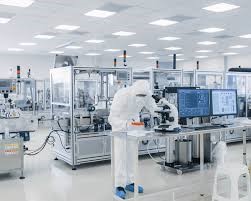Chemical Engineering Processes in Pharmaceutical Manufacturing: Engendering Quality and Efficiency
Chemical engineering is very significant for the pharmaceutical industry. Chemical engineering pertains to the use of principles in the fields of chemistry, physics, and biology. Such a blend helps in the design of processes that will create medications efficiently and safely. Likewise, the use of chemical engineering processes guarantees the best quality and most effective pharmaceuticals.
The work of chemical engineers in pharmaceuticals manufacturing involves the optimization of production processes. They engage themselves in the development of methods to scale up production from laboratory experiments to large-scale manufacturing. This is important to ensure that drugs are brought to the public on time.
All this allows one to understand how everyday medications are made. Understanding what pharmaceutical manufacturing consists of helps value its complication and importance.
\begin{itemize}
\item Chemical engineering is essential for the safe and effective production of drugs.
\item Scaling up pharmaceutical manufacturing depends on the processes optimization.
\item Such knowledge enhances the values with respect to the pharmaceutical industry.
\item Chemical engineer has four key principles:
\end{itemize}
\PageSeparator
\begin{itemize}
\item What chemical engineer uses
\item What chemical engineer makes
\item How
The engineering foundations of chemical engineering in pharmaceutical manufacturing are based upon key principles ensuring safety, efficiency, and quality. The basis of developing an efficient process for manufacturing drugs lies in thorough research related to reaction engineering, process design, as well as thermodynamics.
Reaction Engineering and Kinetics
Reaction engineering concerns the how and under which circumstances chemical reactions take place and how to affect those. Kinetics deals with the rate the reactions occur and the parameters affecting that.
Key elements include:
- Reaction rates: How fast reactants turn into products Endorphins exceed.
- Catalysts: Chemicals that enhance the rate of a reaction without being consumed in it.
- Batch vs.CONTINUOUS: Batch is a process done on a number of fixed quantities. Continuous or processes run indefinitely.
- Good monitoring of these factors allows the optimal yields for the products and minimizes the amount of byproducts. This has great health and safety benefits from when producing pharmaceuticals.
- Process design is intended to create a workflow that brings the entry of raw materials to the final product. Optimization is meant to improve what has happened in this process to have efficiency and that costs have been saved.
Important factors include:
Selecting equipment, such as, for example, reactors, separators, and pumps
Flow diagrams, which are graphical and represent the map for every process stage.
Software—which may include simulation used to predict the way processes are likely to react under different conditions—, for example THE.
Attention to these details ensures that the processes can be scaled up from the lab to full production effectively.
Thermodynamics and Heat Transfer
Thermodynamics is concerned with energy changes in chemical processes. It explains how heat transfer impacts on reactions and product stability.

The key concepts are as follows:
- Energy Balances: Calculating the input and output of energy in reactions;
- Phase Equilibrium: How the different states of matter interact with one another (solid, liquid, and gas).
- Heat exchangers: Transfers heat efficiently from one fluid to another.
- Understanding these principles are of essence in ensuring suitable operational conditions in the pharmaceutical manufacturing process.
Application to Manufacture of Pharmaceuticals
Chemical engineering is of paramount importance to the pharmaceutical manufacturing process. Its importance lies in the assistance in the effectiveness and quality of the industry to deal appropriately with drug manufacture, formulation, and control pertinent subtopics as follows, elaborates salient features of concern in chemical engineering application to manufacture of pharmaceuticals.
Manufacture and Synthesis of Drugs
Drug Synthesis is all about novel configurations of chemical compounds that eventually result in a drug. Chemical engineers have designs for safe and cost-effective ways of synthesis and certainly would think about temperature, pressure, and reaction time within their design. In addition to a host of other techniques, like catalysis and extraction, the engineers have at their disposal in optimizing the yield and reducing the waste.
More advanced methods help in large-scale manufacturing, such as continuous flow production. This approach brings about a reduction in downtime and improvement in efficiency.
Quality control is a crucial element of factor during manufacturing. The results obtained after synthesis are statistically analyzed by engineers to aid similar results in the future. This way, drugs will be administered and meet regulatory quality.
Formulation and Compounding
Formulation refers to the process of combining various ingredients in manufacturing a finished product. The chemical engineers identify the right ingredients known as excipients that support the active pharmaceutical ingredient.
They attend to details like dosing and release mechanisms of medications where medications are supposed to give the right effects. For example, the slow-release formulations improve patient adherence to dosing medications.
Compounding: engineered designing processes that maintain quality but allow for personalization of drugs for individual patients. This is important for individuals with unique health needs or those who may have allergic reactions to some of the drugs’ excipients.
PAT:
Process Analytical Technology represents a system of manufacturing monitoring and control. It is an enabling system to guarantee that the processes used are capable of producing products that meet the required quality specifications at the time of manufacturing.
Chemical engineers monitor important process parameters—composition, temperature, and pressure—using several different analytical tools, just to note a few. The aim is to note any discrepancy and possible problems during manufacture.
The use of PAT develops into better understanding and process optimization, which allows for timely adjustments, lowering the risk of defects. The overall advanced technology lies in the reliability and quality of pharmaceutical products.
Also Read :
- The Rise of Quantum Computing: What It Means for Technology
- The Future of Mobile Technology: Trends to Watch in 2024
- Blockchain Technology: Understanding Its Impact Beyond Cryptocurrencies
- How Blockchain Technology is Revolutionizing Industries
- Climbing technology